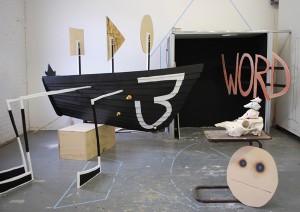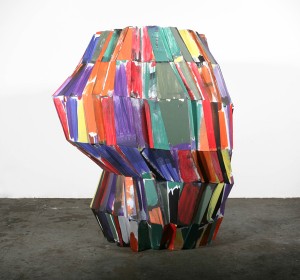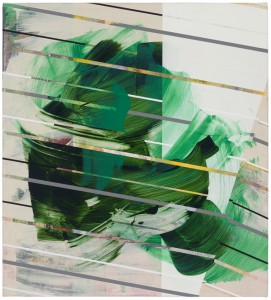10.23.2012 – 5.1.2013 Feature: “New.NewYork,” Essl Museum, Vienna by John Silvis

Brent Dickinson, Studio installation view of Systematic Theology, 2012, mixed media, dimensions variable
Does the contemporary New York art scene have a significant influence on the global biennial landscape? The “New.NewYork” exhibition presents nineteen innovative artists who are making a vital contribution to the art world. As a New Yorker of eighteen years, I’ve recently explored emerging art communities in both Beijing and Berlin, which has prepared me to take a fresh look at the work of my peers, most of whom are based in Brooklyn, with eyes for the larger, global context. The sheer geographical density of New York artists, from recent art-school graduates to more established, prolific artists, does not appear to have been influenced by the post-crash market, indicated by the surprisingly competitive housing rental market, which continues to make it difficult for even established artists to secure adequate work space. While statistics indicate that vast amounts of art and money are changing hands in China, the Middle East, and Russia, New York’s complex art world also flourishes because of its unique cross-generational cohesion, which provides a sustaining intellectual exchange to successive generations of young art makers. The notion of this also applies to layers of art professionals and institutions that set incredibly high standards and continually monitor the quality of exhibited work with clarity of vision unmatched elsewhere.
Postwar New York gave birth to major art movements that significantly defined the second half of the twenty-first century, such as Abstract Expressionism, Post Painterly Abstraction, Minimalism, Conceptualism, Pop Art, Land Art, as well as Performance and Video Art. The fertile landscape of New York’s postwar art scene is historically one of the most significant periods in America’s cultural transformation. The energy of that era can also be attributed to New York City’s compact urban layout that encourages a pragmatic and vibrant engagement within its tight geographical boundaries, a characteristic that continues to provide a potent impetus for dialogue. The now-congested city of New York was designed on a grid system, originally proposed by the commissioner of the city in 1811 to ease the flow of commerce and provide more sanitary living conditions. Manhattan’s so-called grid plan had a tremendous influence on the experiential character of the city and still influences our collective awareness of the urban milieu. One can see the grid repeated in the modernist steel and glass buildings conceived by Mies Van der Rohe and translated in the emergence of minimalist painting and sculpture, as found in the works of Agnes Martin and Carl Andre.
For centuries, New York has been permeated by an ethos of discovery and human advancement on all levels of society. Since Marcel Duchamp’s 1913 introduction of a urinal, “Fountain,” as an art object at the first New York Armory show, artistic practice has been infused with the expectation of innovation. The urgency to experience the New in art is a pervasive ambition that fuels all art production and inspires emerging artists to differentiate their work from the canon of art, while thoughtfully acknowledging their artistic lineages. The artists in “New.NewYork” explore the New by either transforming ordinary mass-produced materials into precious, highly considered objects, or by challenging the formal parameters of their respective mediums, which include fiber art, installation, painting, photography, sculpture and video. These pursuits create a fluid interchange of artistic processes that shape ideas into the exciting visual objects seen in this exhibition.
Even a cursory scanning of the “New.NewYork” exhibition will reveal a relative absence of the human figure or other forms of representation. Some of the artists explore their personal histories allegorically by weaving them into their formalist compositions, or by quoting personal narratives as a primary source of inspiration, definitively illustrated in the work of Steven and William Ladd and Brent Dickinson. With the exception of Shelly Silver and Egan Frantz, the artists in the exhibition moved to New York to become active participants in the art world and to build a sustaining community around them. The process of understanding the complexities of art-world networks, combined with the financial struggle to maintain a basic standard of living while having enough time and space to create enduring work is a colossal endeavor. The dedication and resolve of the artists represented here is truly inspiring.
The cultural and intellectual diversity of young artists in New York is unmatched by any other city in the world and consequently encourages artists to set high standards for themselves. And yet, there is an enormous amount of comradery in the New York art world, which willingly shares and disseminates information. As I endeavored to visit seventy-plus studios in preparation for “New.NewYork,” most of the artists in the exhibition gladly introduced me to their peers without solicitation, despite the potential risk of not being chosen to participate in the show. Their comradery extends to the value they place on examining recent intellectual history and building on the ambitions of the generations of artists that preceded them. A poignant example of this is the Minimalist impulse in the works of Sarah Lee and Rob Fischer, who explore a decidedly more humane version of Minimalisim’s historic principles.
Another important characteristic that I considered during the “New.NewYork” selection process was the entrepreneurial quality of the artists’ studio practice. Drawing from many disparate genres and conceptual oeuvres,the artwork that impressed me was rooted in a clear lineage to the important art movements that developed in New York over the last fifty years and translated its ideological essence into compelling contemporary propositions. While not always working intentionally within the trajectory of recent art history, the continuity and thoroughness of artistic vision is quite apparent in their work. For example, the work of Siebren Versteeg aesthetically mirrors the loose brushwork of Abstract Expressionism, while removing it conceptually and physically from that history. Though in some cases the work’s artistic roots are less specific, the objects and images in this exhibition were chosen for their masterful reinterpretation of common materials, a trend that was pioneered by more established artists such as Tara Donovan, who lives and works in Brooklyn.
New York’s vibrancy is firmly grounded in the inter-generational fascination with the new and a concerted willingness by its many patrons to support unchartered artistic visions. At the core of this commitment lies a fundamental belief in the power of human ingenuity and community. New York continues to embody progressive optimism as it welcomes new groups of artists to contribute to the ongoing dialogue of collectors, dealers, critics, art advisors, museums, and artists, which affirms artistic accomplishment by means of complex consensus. Even though the global art world is expanding rapidly, and new centers of influence are likely to emerge over the coming decades (foreshadowed by the recent stock-market crash and China’s surpassing of the United States as the world’s largest art market), the depth and open spirit of the New York art community continues to provide fertile ground for its dedicated participants to flourish.
Exhibition Artists: Jude Broughan, Vince Contarino, Brent Everett Dickinson, Rob Fischer, Ryan Ford, Egan Frantz, Rico Gatson, Robin Kang, Steven and William Ladd, Sarah Lee, Christopher McDonald, Ann Pibal, Lisa Sigal, Shelly Silver, Reid Strelow, Siebren Versteeg, Letha Wilson, and Tamara Zahaykevich.
Tags: Journal
